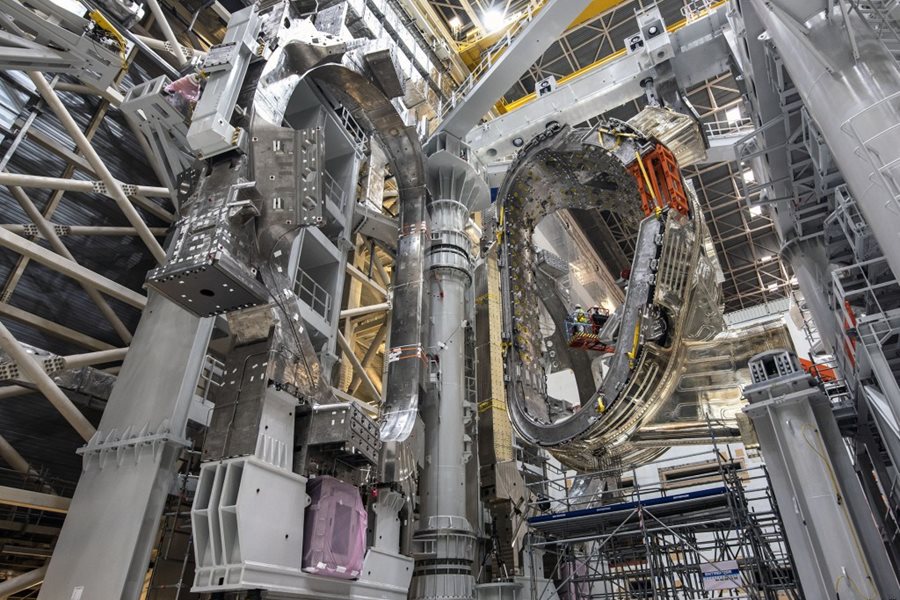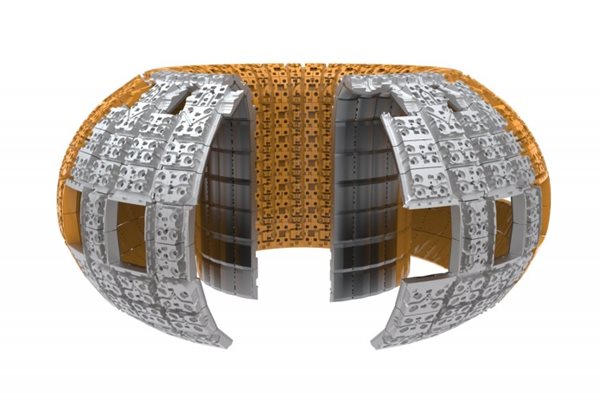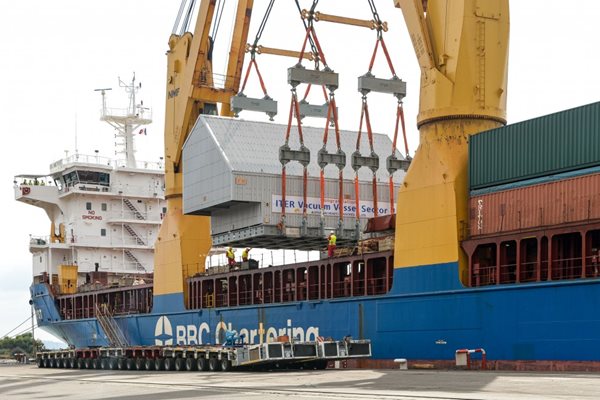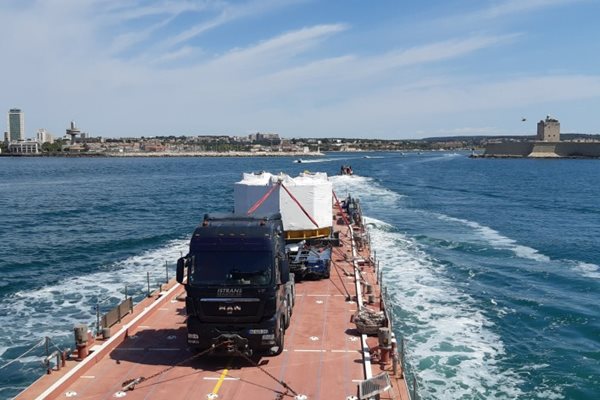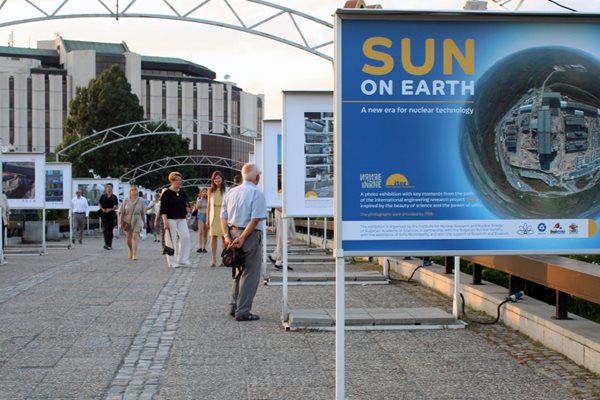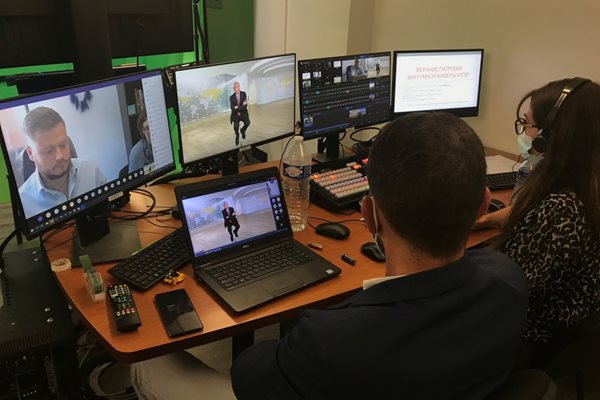
you're currently reading the news digest published from 26 Jul 2021 to 30 Aug 2021
featured7
press82
featured
Assembly | First "building block" takes shape
Although it comprises hundreds of thousands of components, a tokamak is essentially a toroidal chamber surrounded by magnetic coils. In ITER, the 'chamber,' or vacuum vessel, is made of nine 40° sectors, five of which are provided by Europe, the other four by Korea. In the assembly sequence, each sector needs to be associated with two vertical coils, either from Europe or Japan, plus thermal shielding before being lowered and positioned in the assembly pit. This so-called 'sub-assembly' is the basic building block of the machine. In the ITER Assembly Hall, inside one of the tall sector sub-assembly tools (SSAT-2), the first of these building blocks is progressively taking shape. In April, following an eight-month preparatory campaign after it was delivered to ITER, the first vacuum vessel sector from Korea was safely docked, and later equipped with its corresponding thermal shield panels. Panel alignment was confirmed in mid-July. In June, one of the two vertical coils (TF#12 from Japan) set to be attached to the vacuum vessel sector was extracted from its steel cradle and moved to temporary storage inside SSAT-1. There were several reasons for this stopover: one was the lack of available space in the Assembly Hall and the other the necessity of rehearsing the highly delicate installation of one-of-a-kind component inside a one-of-a-kind tool. On 10 August, TF#12 was moved into SSAT-2, followed two days later by its twin TF#13, also from Japan. Both coils are now ready for their final embrace of the vacuum vessel sector. Over the past year, the Assembly Hall has been the stage of many a spectacular operation: components of all sizes, shapes and weight (up to 1,250 tonnes) have been lifted, upended, transported and installed. Some looked like flying saucers, others like a giant Life Savers mint; some were just plain steel, others shone like a silver armband. What is happening now in the core and wings of the 20-metre-tall sub-assembly tool is no less spectacular but even more alien. Picture three massive components, each as heavy as an Airbus A380 or a fully loaded Boeing 747. The one standing at the centre, smooth on the outside, is pockmarked with dozens of small cylindrical devices like a whale colonized by barnacles. It is the vacuum vessel sector, encased in its silver-plated thermal shield panels. On both sides of the D-shaped mastodon, the tool's wings stand open, each holding a component of the same general outline, but thinner and sturdier, full of extensions and protruding parts. The twin components' appearance is even stranger than that of the vacuum vessel sector and it takes some knowledge of a tokamak's architecture to identify them—they are the toroidal field coil pair that will be integrated onto vacuum vessel sector #6. For the moment, nothing is moving except the workers and elevated platforms around the tool. In the coming weeks, when all measurements, alignments and adjustments are done, the tool's wings will begin to move, very slowly, to bring the coils closer and closer to the vessel sector and eventually lock them into place. The process will be a careful and extremely precise one. And although all eyes will be focused on the operation unfolding in the Assembly Hall—the first of nine that must be realized to close the ITER torus—no fewer than 27 construction work packages have to be executed, some deep inside the Tokamak pit, to prepare the way for the installation the first vacuum vessel sector sub-assembly. To this day, 8 of the 27 work packages have been achieved. In late October, the first 1,200-tonne vacuum vessel sub-assembly of the ITER device will be ready for lift off. This 4D animation by Brigantium Engineering France for the ITER Organization shows how the 1,200-tonne sub-assembly will be transferred from the sub-assembly tool to its final destination inside the assembly pit.
Blanket | Integrated team holds 100th meeting
The 'Century Meeting' of the Blanket Integrated Product Team was held from 30 June to 1 July 2021 by Skype. To commemorate the event, several past contributors joined, including the first Blanket Integrated Product Team (BIPT) leader, Doug Loesser from the Princeton Plasma Physics Laboratory. Loesser led the BIPT from 2009 to 2010 and was succeeded by René Raffray, who has led the BIPT ever since. ITER Director-General, Bernard Bigot, opened the 100th BIPT meeting with introductory remarks, tracing the history of the BIPT and highlighting the major accomplishments from pre-conceptual design in 2008 to the signatures of seven Procurement Arrangements, and now series production. The next goal is to have the components manufactured and delivered according to specification and on time. Following the introduction, the meeting proceeded as most of the previous 99 BIPT meetings had. Different groups reported progress in several areas—including production and storage, integration techniques, validation procedures, and design reviews for diagnostic components. A complex system requires close coordination The blanket is a particularly complex system—even by ITER standards. It covers a plasma-facing surface area of 610 m², and consists of 440 individual blanket modules. Each module has a relatively thin first wall panel in the front, mounted on a relatively thick shield block at the back. The front part of the module faces the ultra-hot plasma; the back part has features that allow it to be attached to the vacuum vessel. Blanket modules must accommodate high plasma heat fluxes (up to 4.7 MW/m²) and particle fluxes on the first wall as well as powerful electromagnetic forces. At the same time, they must provide essential neutron shielding to protect the components at the back—in particular, the vacuum vessel and the cryogenically cooled superconducting magnets, which operate at around 4 Kelvin (-269 °C). On top of all that, the blanket modules must accommodate the space allocations for in-vessel coils, manifolds, plasma heating systems and diagnostics. The ITER blanket will be the first actively cooled blanket operating in a fusion environment. Blankets will be an essential feature of all tokamak-style fusion reactors, providing a giant barrier to stop most of the neutrons generated by the fusion reaction. In the process, blankets convert energy from the neutrons into heat and shield the superconducting magnets and vacuum vessel from the neutrons. Blankets in commercial reactors will have additional features that generate tritium to serve as fuel for the reaction. Neutrons smashing into lithium-containing areas of these future blankets will result in small nuclear reactions that produce tritium fuel, and heat that is channeled for use in the reactor. To avoid adding another layer of complexity, the ITER blanket has not been designed to produce tritium fuel—instead the installation will rely on purchased tritium. However, ITER does have a test blanket module program, which will test mockups of tritium-breeding blankets installed in equatorial ports. The BIPT stands out as a successful example of an Integrated Product Team Having different organizations work independently to produce complex components that fit together to make a working system is a risky proposition—especially when the system is first-of-a-kind. To head off the potential hazards, the ITER Council decided in November 2008 to create Integrated Product Teams (IPT) to combine the resources and capabilities of ITER Organization and the Domestic Agencies and channel them to work as a single team with a sense of shared design ownership. The Blanket IPT was one of three inter-organizational teams created at that time for similar reasons and it is the only IPT still in operation. With a long list of accomplishments that attest to the success of the team over more than a decade, René Raffray is looking to the future. 'The BIPT success is based on a lot of work,' says Raffray. 'We have been fortunate to have had well over 200 people contributing to the BIPT over the years. We have encouraged open discussion at meetings, developed a sense of trust and teamwork, and held some positive team-building activities outside the meetings. It was important for the whole team to have a say in the design and to feel a sense of ownership. This has worked—and now we have brought the blanket system all the way to procurement.' 'We will continue to run the team in as collaborative a manner has possible,' continues Raffray. 'We still need open discussion on ongoing procurement activities, especially when several Domestic Agencies procure the same components. We need to make sure issues are solved in a transparent way, and that all parties feel they are being heard.' 'We have a strong foundation on which to continue building. But the usefulness and success of the BIPT in the future will really depend on the ongoing contribution of each team member from the Domestic Agencies and the ITER Organization, and on how they make the most of this platform to progress on procurement of the different blanket components.' After all, this 100th meeting is far from the last. Bernard Bigot ended his introductory speech by offering his steady support to the ongoing BIPT effort as it works towards Pre-Fusion Power Operation 1 in 2028 or 2029.
Deliveries | 2nd vacuum vessel sector from Korea
One vacuum vessel sector is already positioned inside a giant sub-assembly tool, ready to be associated with two vertical coils and thermal shielding to form the first sub-assembly of the ITER Tokamak. A second sits on stillage at the other end of the Assembly Hall, still wrapped in its protective plastic sheet. The latest sector, which shipped from Hyundai Heavy Industries in Ulsan, Korea, on 24 June, was delivered to the ITER construction site in the early hours of 27 August. Called sector #1(7)*, it is the second vacuum vessel sector delivered by the Korean Domestic Agency of four that it will procure in total; two other sectors are respectively 96 percent and 89 percent complete in Korea. Five other sectors are also progressing under European responsibility. Procured from the AMW consortium (Ansaldo Nucleare, Mangiarotti, Walter Tosto, and sub-contractors), they range in completion from 72 to 94 percent. The nine 40-degree sectors required to form the ITER toroidal chamber are largely similar, differing only in the details relevant to their position in the circular arrangement and interfacing components. 'Like sector #6, delivered last year, sector #1(7) is a 'regular' sector, meaning that it interfaces with standard equatorial port plugs. This contrasts with 'irregular' sectors that interface with features such as neutral beam penetrations,' explains Vacuum Vessel Section Leader Alex Martin. 'The slight differences between the two sectors we have on site are in the inner rails, the triangular support, and penetrations in the lower area to meet specific interface requirements.' Like its predecessor, sector #1(7) will go through a series of operations in the Assembly Hall, such as the installation of diagnostics and instrumentation, before it is upended and moved to the sub-assembly tooling to form the second of the ITER Tokamak sub-assemblies. * Readers will have seen this sector referred to as #7 in past articles. In fact, sectors #1 and #7 (both supplied by Korea) are nearly identical. It was decided to install Korea's second sector (#1) in the place of #7 in the assembly pit at ITER—hence the name '#1(7)'—in order to accelerate the assembly of the torus chamber. The sectors in positions #6 and #7 in the assembly pit will be the first of nine to be welded together.
In memoriam | Arun Srivastava, former ITER Council Chair
Some very sad news reached ITER and the broader fusion community on Wednesday 18 August: Arun Srivastava, who had served as the sixth Chair of the ITER Council from January 2018 until the end of 2019, had passed away that very morning. A longtime contributor to ITER, Arun experienced first-hand every step of the project's progress, representing India on the ITER Council and its many sub-committees before becoming Council Chair in 2018. As Chair, he will be remembered for his energy, infectious enthusiasm and reliability. Arun was both an engineer and an administrator. A chemist by training, he graduated in 1983 from the Laxminarayan Institute of Technology (LIT), Nagpur, India, and later obtained a postgraduate diploma in Management Studies from Mumbai University. A graduate of the Bhabha Atomic Research Centre (BARC) training school, he was involved in the design, construction and commissioning of the Manuguru Heavy Water Plant, and joined India's Department of Atomic Energy (DAE) in the late 1990s. In 2010, he was appointed Secretary of the Atomic Energy Commission, the highest policy-making body for atomic energy in India. Arun saw nuclear energy as a way to provide 'a better quality of life to India's citizens,' contributing not only to electricity production but also, through the development and deployment of nuclear and radiation technologies and their applications, to better health care and improved food production. Arun will also be remembered for being one of the driving forces behind the organization of the 2019 Vigyan Samagam project—a travelling exhibition that showcased India's contributions to cutting-edge research megaprojects, including ITER, worldwide. At ITER, and in many other places, he will be deeply missed.
Deliveries | Busy times on roads and oceans
It is a busy time for transport and deliveries. Major ITER components are presently sailing the Indian and Pacific oceans, driving on the roads near Houston, and travelling by night along the ITER Itinerary. Shipped in early July from the United States, the first central solenoid module was unloaded at Fos-sur-Mer on 25 July and is expected on site on 9 September. A second module has already travelled approximately 2,400 kilometres between the General Atomics facility near San Diego, California, and the port of Houston, Texas. Now, it is ready to cross the Atlantic. On other points of the globe, three toroidal field coils are heading in the direction of ITER. Toroidal field coil #6 from Europe (TF6) was unloaded at Fos-sur-Mer on 20 August and will be delivered on 3 September. TF2 from Japan left the port of Kobe on 23 August and will reach southern France at the end of this month; a second Japanese coil, TF10, sailed from Yokohama on 20 August and should arrive at Fos-sur-Mer at about the same time. These five major components arrive on the heels of vacuum vessel sector #1(7), which travelled this summer from Korea and reached ITER on 27 August. All in all, since the first Highly Exceptional Load was delivered in January 2015, 130 such shipments have been organized and safely received at ITER. Over the past year and a half, the rhythm of major component deliveries has significantly accelerated as machine assembly got off to a start.
Exhibition | The beauty of ITER in Bulgaria's capital
From 10 to 23 August, pedestrians strolling across the 'Lovers' Bridge' in downtown Sofia, Bulgaria, were given a unique opportunity to get acquainted with ITER. The 'Lovers' Bridge' in Sofia is an open-air gallery that has accommodated many prestigious photo exhibitions, including the famous 'Earth From Above' exhibit by French photographer Yann Arthus-Bertrand. From 10 to 23 August, the large framed photographs on both sides of the bridge were of an unusual kind: they were about the beauty of ITER. Hosted by the Institute for Nuclear Research and Nuclear Energy (INRNE) of the Bulgarian Academy of Sciences, with contributions from the municipality of Sofia, the Bulgarian Nuclear Society, and the Russian state corporation Rosatom, the exhibition titled "Sun of the Earth — A New Age in Nuclear Technologies" comprised some 30 large-format photographs of ITER, portraying massive tools, buildings, people and components. Among the hundreds of photographs available through the ITER Newsline, website, or publications, the organizers selected those that 'not only showed the development of the project, but also offered an impressively beautiful view of science and technology.' In showcasing ITER—'a pure example of what united minds can achieve together'—as well as Bulgaria's contribution to the project, the organizers also sought to highlight the importance of international collaboration and 'the benefit that a successful partnership between science and industry brings to society.' In-vessel coils engineer Anna Encheva, who is one of four Bulgarian staff members at ITER, was on hand to provide explanations to visitors and the media. 'This exhibition was a very moving experience for me", she says, "as if the ITER environment had been transferred to my home. The people and the media I interacted with knew very little about the project. But when I described our work, the challenges we are facing and the ultimate goal we are pursuing, they were just fascinated...'
Outreach | ITER Russia Media Day 2021
On 24 August, the ITER Organization and the Russian Domestic Agency held a virtual press conference for 17 journalists from the leading Russian press agencies and publishers. Moderated by Laban Coblentz, head of ITER Communication, the event started with a presentation by ITER Director-General Bernard Bigot on the history and the importance of the ITER Project and fusion energy as well as updates on progress in construction and assembly of the ITER reactor. The Director-General also drew attention to the importance of the transition to a new source of energy in order to answer global economic and environmental needs—one of the key goals of the ITER Project. The media tour continued with a welcome address from Anatoly Krasilnikov, ITER Russia head. The greatest achievements of the Russian Domestic Agency now include the supply of all upper ports for the ITER vacuum vessel ahead of schedule, and the near completion of one poloidal field coil. He also emphasized the admirable level of international collaboration in the construction of the world's largest fusion reactor. ITER Vacuum Vessel Coordinator Engineer, Yuri Utin, presented the upper ports of the vacuum vessel, some of the most important components of the reactor. Since the upper ports are connecting components, their on-time delivery is crucial for the successful assembly of the vacuum vessel and, in turn, the entire reactor. The event finished with a virtual tour of the ITER worksite, giving participants the chance to see the spectacular ITER facilities with their own eyes. Within the first 30 hours of the event, 10 articles had been published in the Russian media.
